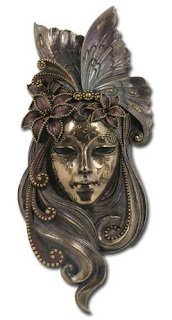
I have already touched on the idea of the reasons behind why we wear the clothes we do. Whether we mean to or not, we all project an image of ourselves by the way we dress, but is the image we are projecting a true one? Here I take a deeper look at the conflicting ideas of clothing as a mask and clothing as an bonafide extension of ourselves.
Masking Our Identity?
From a psychoanalytical point of view, Flügel believes that “when we wear a mask, we cease, to some extent, to be ourselves; we conceal from others both our identity and the natural expression of our emotions”1. A mask’s ability to hide the most important part of the body for visual identification, the face, appears to also hide our individual identity. Clothing is not only used for function and protection but has, for hundreds of years helped to establish a person’s identity and status. But is the identity which is established a true or false one? How can we tell?
It is clear that while a mask can hide your true self, it is often for the sake of self-improvement and that there is always a motive for wearing a mask of any sort, be it on the face or in terms of clothing on the body. For example, the clothing worn to an interview must project the best person you can be. Whether or not it accurately represents the person wearing it, the outfit represents and promotes a character that they want to project.

An Extension Of Our True Identity?
While a mask can be seen as a disguise, it has also been argued by theorists such as Ducasse that if there is consistency in clothing we wear it becomes an extension of our identity; a part of the self. Mauss believes that “body decoration creates a person expressive of the ‘inner self’"2, an idea which questions whether or not what we choose to wear is personal expression. If it is an active choice to wear a particular item of clothing, is it therefore an extension of our own identity or a projection of who we strive to be?
Theorists who give these decisions the benefit of the doubt such as Flügel believe that through the very experience of wearing clothes, you are physically extending your personality and character into what you wear. The confidence that this brings to the wearer could arguably help them project the true self that they felt they could not show before.

Self Improvement & Improvement On Nature
Kant expands on Flügel’s theory, emphasising how beauty can be restricted by nature’s limits and as such, clothing as an ornamental mask extends the identity and beauty of a person, “the beautiful in nature is connected with the form of the object, which consists in having boundaries”3.
The idea of nature’s boundaries is a continuing concept throughout this debate and is essentially what it centres around. Darwin has observed the human need to improve their natural appearance, “Man admires and often tries to exaggerate whatever characters nature may have given him”4. Through clothes we are able to create new forms of ourselves and can change the way our faces and bodies look. We only have to look to the crinoline of the 19th Century to see that the idea of hiding and moulding the body into something it is not has been around for hundreds of years and as such has become a mask, a form of disguise.

Objectification & The Reactions Of Others
Our own personal motives for the way we dress can vary hugely, but in reality they are all based on the same reason: controlling how we are seen by others. Barthes examines the effect of being looked at as an object, “in front of the lens, I am at the same time: the one I think I am, the one I want others to think I am”5. When we are aware we are being observed or judged we have an inbuilt tendency to promote who we believe we are or who we want others to believe we are.
The impact of fascination further expands on this point. Despite our desire in the modern day to express our individuality, particularly through the clothes we wear, we are still pack animals and therefore are constantly seeking approval for our actions and appearances. Fascination is an emotion that is stimulated by aesthetics and as a result is the main factor in first impressions.
Drawing on Freud’s theory of the Id, Ego and Superego, which states that the Superego conditions us into being highly aware of what is socially acceptable. This transfers into the clothes we wear as the reactions we receive from others are processed and transferred into our own personal tastes. We want people to be fascinated by and attracted to us, and project an image to suit this persona.
1 Flügel, J. C., The Psychology of Clothes, Hogarth Press, 1950
2 Mauss, M., Sociology and Psychology, London RKP, 1979
3 Kant, I., Critique of Judgement, Hafner Press, 1951
4 Darwin, C., The Decent of Man, Penguin, 2004
5 Barthes, R., Camera Lucida: Reflections on Photography, Vintage, 1933
No comments:
Post a Comment